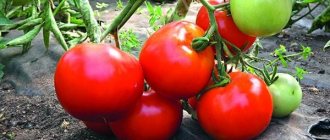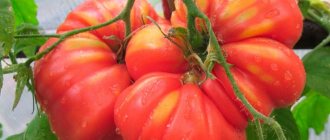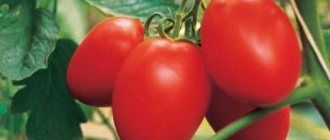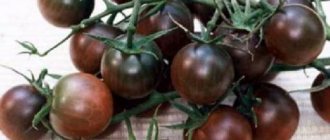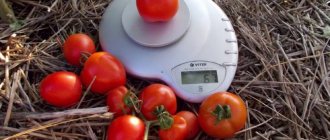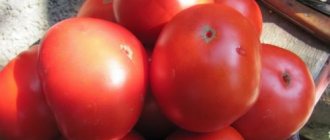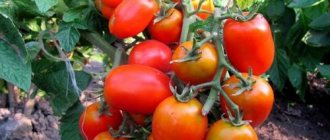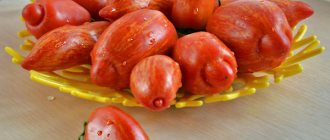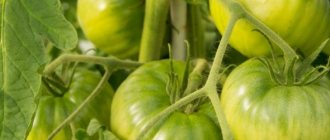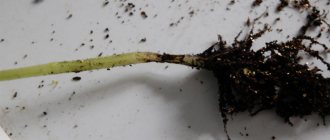Agronomist expert Expert in planting your garden bed Suggest an article
- Join us
Join us and follow the news on social networks
Home › Planting and growing › Vegetable garden › Solanaceae › Tomato
413
Every gardener wants to taste the tomato fruits grown on his plot as early as possible. But the first harvest of most varieties is harvested at the end of July. Early ripening tomatoes are often only suitable for growing in a greenhouse, or they have an unexpressed taste and hard flesh and yield a small harvest too quickly. Therefore, in search of the best option, novice gardeners often encounter disappointments over and over again.
Thanks to modern breeding, varieties have appeared on the market that are devoid of all the described disadvantages and are suitable for cultivation in the harsh climate of the middle and northern regions of Russia. These include the early ripening tomato Yamal. Are there any disadvantages to this variety and how to get maximum yield - read on.
- General description of the variety Distinctive features
- Characteristics of Yamal
- Pre-treatment of seeds
- Planting in open ground
General description of the variety
Yamal is a tomato variety bred by domestic breeders . Its creator is considered to be agronomist V.I. Kozak.
Yamal is not included in the state register . Despite this, the variety is produced by many manufacturers: it enjoys stable popularity among gardeners from the countries of the former CIS.
Note! When buying tomato seeds that are not included in the state register, be especially careful. An unscrupulous manufacturer may place low-quality planting material in packaging.
Distinctive features
Yamal is an early ripening variety . With proper agricultural technology, the first harvest is obtained at the end of June. Unlike many other early tomatoes, it bears fruit long before the first frost.
Yamal has ordinary fruits that do not stand out among other tomatoes . They are red, small in size and round in shape.
Tomatoes taste sweet and sour, with a characteristic tomato aroma . For early ripening varieties, they have a rich taste.
A distinctive feature of this variety is the miniature size of the bushes . The tallest specimens do not grow up to 50 cm. Thanks to this, the tomato does not need to be shaped.
Gardeners in our country love Yamal for its resistance to cold weather . It is able to set fruit even at low temperatures. In addition, the variety tolerates drought.
Tomatoes have immunity to all diseases characteristic of this crop. Therefore, it does not need to be frequently treated with means to prevent infection of bushes.
About other varieties of tomatoes:
Features of growing the tomato hybrid "Tornado"
Is it worth planting the hybrid tomato "Red Arrow F1"
A favorite for growing in a greenhouse is the “Babushkino Lukoshko” tomato.
Characteristics of Yamal
The variety is ideal for growing in our country . It withstands all negative environmental influences, delighting gardeners with a tasty and abundant harvest.
Characteristics and description of the variety:
| Parameter | Indicators |
| Bush type | Determinant. Standard. It reaches a height of 35-45 cm. The bushes are spreading, medium-leaved. The leaves are large, simple, slightly corrugated. The color of the leaves varies from light green to dark green. The stems are thick and strong. The inflorescences are simple. The first is laid in the axil of 5-7 leaves, the rest - every 1-2 leaves. |
| Growing method | They are mainly grown in open ground in all regions of our country. Cultivation in a greenhouse and on a balcony is possible. |
| Productivity | High. From 1 sq. m harvest from 10 to 17 kg of berries. |
| Fruit | Average. The first fruits weigh 150 g. Then the weight of the berries gradually decreases to 70 g. The tomatoes are red inside and out. There is no green spot at the base. The shape of the tomatoes is round, sometimes slightly flattened. In most cases, there is no ribbing at the base. The tomatoes taste sweet and sour, with a pronounced tomato aroma. Chambers with an average number of seeds in fruits from 2 to 5. |
| Transportability | High. The strong skin protects the fruits from mechanical damage and allows them to be stored for more than a month. |
| Ripening time | The variety is early ripening. Depending on the outside temperature, the first ripe fruits appear after 90-100 days. Fruiting continues until the first frost. |
| Disease resistance | Has high immunity to major tomato diseases. |
Characteristics
- The country where the variety was bred is Russia.
- Round and flat-round shape of the fruit with a small pit at the stalk, weakly expressed ribbing.
- Unripe tomatoes are light green, ripened tomatoes are rich red.
- Universal use, medium-sized fruits of excellent taste are good for pickling, excellent in salads, slices, and sauces.
- The first fruits weigh 110-115, the next 68-80 grams.
- Good presentation, dense, medium-sized tomatoes are perfectly preserved during transportation.
- The average yield is from 9.5 to 17.0 kilograms per square meter, largely depending on the conditions of planting and care.
You can compare the yield of this variety with others in the table below:
| Variety name | Productivity |
| Yamal | 9.5-17 kg per square meter |
| Polbig | 4 kg per plant |
| Kostroma | 5 kg per bush |
| Lazy | 15 kg per square meter |
| Fat Jack | 5-6 kg per plant |
| Lady Shady | 7.5 kg per square meter |
| Bella Rosa | 5-7 kg per square meter |
| Dubrava | 2 kg per bush |
| Dad | 6 kg per bush |
| Pink spam | 20-25 kg per square meter |
Growing seedlings
Yamal tomato seedlings begin to be grown 55-60 days before planting tomatoes in open ground. The time for sowing seeds depends on the region :
- southern cities - early March;
- central regions – end of March;
- northern part of the country - early April.
Pre-treatment of seeds
To grow high-quality seedlings and increase germination , you need to properly prepare the seeds.
To begin with, they sort through the planting material, removing all damaged and darkened seeds . To check planting material for germination, it is soaked in an aqueous salt solution for half an hour. Floating specimens are considered unsuitable for planting. The seeds that have sunk to the bottom are washed, dried and used for planting.
To prevent infection of tomatoes, the seeds are treated . To do this, they are soaked for 30 minutes in a weak solution of potassium permanganate or for 10 minutes in hydrogen peroxide. After this, the planting material is washed.
At the last stage, tomato seeds are treated with a growth stimulator - wrapped in pieces of gauze soaked in a special solution for 6-8 hours. Products containing nutrients are used as a stimulant.
Selection of containers and soil
Yamal seeds are often sown in one large container . Suitable containers can be purchased at the store or made independently. To do this, use cut bottles, cake packaging or trays from semi-finished products.
Plant the seedlings into individual small pots with a volume of 300-500 ml. It is most convenient to use peat pots, from which you do not have to remove the seedlings when planting them in a permanent place. Plastic containers are also suitable for these purposes.
The soil for tomatoes should be light and nutritious . To prepare it, mix chernozem and sand in equal proportions. Sometimes peat and humus are added to this composition. Suitable soil mixtures are sold in specialized stores. Ready-made peat tablets are also used.
The soil and containers are disinfected before use . The soil is watered with boiling water or a dark pink solution of potassium permanganate or calcined in the oven. The containers are soaked for half an hour in a strong solution of potassium permanganate.
Planting seeds in the ground and without soil
To sow seeds in the usual way, grooves 1 cm deep are made in the soil at a distance of 3 cm from each other. Seeds are placed in them at intervals of 2 cm.
After this, the depressions are covered with soil . The soil is moistened with a spray bottle, and the containers are covered with film and placed in a place with a temperature of 23-25 degrees. At this stage, tomatoes do not need light.
Such unpretentious varieties as Yamal are sometimes grown without land . At the bottom of a deep container, place several layers of napkins or toilet paper, which are moistened with a spray bottle. Seeds are laid on them, covered with several more layers of paper, which is also moistened with warm liquid. The containers are covered with film and placed in a warm place. When the paper dries, it is wetted again.
Attention! After the seeds germinate, they are immediately planted into individual containers. You cannot wait for real leaves to appear, since the paper does not contain the necessary nutrients.
Seedling care
Seedlings require regular care . At this stage, the plants are fragile, and unfavorable conditions negatively affect their condition.
Rules for caring for tomato seedlings:
- After the seeds germinate , the film is removed from the containers. The boxes with seedlings are moved to a well-lit place.
- Tomatoes are planted in individual pots after the first true leaves appear on the plants. A layer of drainage is poured onto the bottom of individual containers.
- The seedlings are watered as the soil dries . During watering, liquid should not fall on the bushes. Use only settled water at room temperature.
- The seedlings are fed for the first time 14 days after picking. Fertilizers are applied a second time after another 2 weeks. Tomatoes are fed for the last time 3-5 days before planting the seedlings in a permanent place. The last feeding should contain phosphorus.
- Two weeks before planting in a permanent place, the seedlings begin to harden. To do this, it is taken out to the balcony or outside every day. The first time for half an hour, then the time is doubled. So gradually the time the plants spend in the fresh air is increased to 16 hours.
Growing Yamal tomatoes: a step-by-step guide
Like many other hybrids, the Yamal tomato (the characteristics and description of the variety is above) is grown mainly by seedlings. This is explained by the fact that when planting directly in the beds, the harvest can be obtained a whole month later. We divided the whole process into several stages.
We grow seedlings
This is a rather complicated process, especially if it is done at home. The first thing to do is prepare everything you need.
You need to prepare the following:
• Light and loose soil. You can buy ready-made or prepare it yourself (garden soil, peat, sand, humus are often used). When choosing the second option, do not forget to destroy all living organisms in the soil. To do this, fry it in the oven, pour boiling water or a solution of potassium permanganate over it. • Suitable containers. First, the seeds are usually planted in one large box, and then the sprouts are transplanted into separate cups or pots with a volume of at least 0.5 liters. All containers must be equipped with drainage holes at the bottom. Many farmers prefer not to injure the roots of young plants, so they sow the seeds directly into separate peat pots. This way you can avoid picking and plant sprouts along with containers in the beds. • Lighting. For tomato seedlings to look healthy, they need 12-16 hours of daylight. Only additional lighting can provide this condition, because at the beginning of spring there is not enough sunlight. Use LED or fluorescent lamps for this purpose. Incandescent lamps are least suitable. • Seeds. Choose seeds only from trusted manufacturers, otherwise you risk not getting the result you expect. You can independently collect material for planting next season only from non-hybrid varieties.
Preparing the seeds
Seeds that you are not sure about, pickle them in a solution of potassium permanganate for 20 minutes or in hydrogen peroxide (2-3%) for 10 minutes. After this, many summer residents prefer to germinate the seeds. To do this, they place them in warm water for 10-20 hours (it needs to be changed periodically), and then lay them out between layers of wet cloth and wait for germination. Planting should begin when the shoots just appear. Large sprouts may break when planted.
How to remove shellac at home without special liquid, foil, or product from extended nails. Video
Let's start landing
The best time for the event is the last ten days of March. Place the seeds on the surface of the soil in a box, keeping a distance of 1 cm, spray them with warm water and sprinkle with a centimeter layer of soil. Now you can cover the container with a bag and place it in a well-lit place where the temperature will be 24-25 °C.
Caring for seedlings
What to do after the shoots appear? We provide you with a description of the main recommendations:
• As soon as sprouts appear above the ground, remove the cover and leave the container in conditions of good lighting and low temperature (15-16 ° C). • After a week, raise the air temperature to 20-22 °C. • When 1-2 leaves develop, seedlings should be planted in separate pots. • One to two weeks before planting, begin hardening off the seedlings by moving them outdoors. At first it can be for half an hour, and at the end for the whole day. • At 60-65 days of age, transplant the plants into beds.
Water the seedlings moderately so that the moisture does not stagnate. But don’t let the soil dry out either. Don't forget to loosen the soil regularly. Provide additional light to tomato seedlings from 12 to 16 hours a day. If the soil is initially not nutritious enough, feed the young tomatoes with a suitable product.
Agricultural technology
Yamal tomatoes are planted in a permanent place when the soil warms up and the threat of frost disappears. Disembarkation times vary by region :
- southern - end of April;
- central – after May 10;
- northern - the last days of May or the beginning of June.
High-quality plants should not be stunted or overgrown.
Sowing seeds directly into open ground is possible in the southern and central regions . But in this case, the harvest will be harvested much later.
Planting in open ground
For tomatoes, choose the sunniest place in the garden . Potatoes should not grow near the beds. In autumn, the selected area of the garden is cleared of plant debris. Humus is spread over the beds. If you need to reduce the acidity of the soil, dry lime is added to it.
In the spring, the beds are dug up . Formed plant roots are removed. Then they are watered with a solution of chicken droppings and ash.
The holes are dug in staggered rows . A 50×60 pattern is used. For 1 sq. m place 4-5 plants. A liter of water is poured into each well. The plants are removed from the pots along with a lump of earth, placed in holes and buried down to the first lower leaves, which are removed.
Basic rules for caring for plants
Yamal bushes do not need shaping . They don't need to be stepsoned. Experienced gardeners advise removing a few leaves at the bottom of the bush. But since many fruits form on the bushes, under their weight they bend to the ground. Therefore, despite the low growth, the bushes of this tomato are tied up. For this, a synthetic thread is used.
Water the tomatoes every 2 days . Use at least 2 liters of warm water per plant. Water should not fall on the above-ground part of the bush.
After each moistening, the soil is loosened . This prevents the formation of an earthen crust that disrupts root air exchange. The tomato beds are weeded every week. Weeds need to be removed while they are still weak and small. Otherwise, they will damage the roots of the tomatoes.
Tomatoes are fed every two weeks with root and foliar fertilizers.
Not only early, productive, but also sweet tomato Yamal 200
How to get maximum yield
From 1 sq. m of Yamal tomato harvests from 9 to 17 kg of fruit . To get the maximum harvest in the earliest possible time, you need to know a few tricks.
Fertilizers play an important role in growing Yamal. Every 2 weeks use the following formulations :
- Take 10 g of ammonium nitrate and 40 g of “Superphosphate” per bucket of water. Tomatoes are fed with this composition 10 days after picking in a permanent place.
- Then, every 2 weeks, “Nitrophoska” and ammonium nitrate are added.
- are sprayed with foliar fertilizers every week . To prepare such compositions, take 10 g of “Superphosphate”, potassium sulfate and urea per bucket of water.
On hot days, the frequency of watering is increased . One plant should require 2.5 liters of water.
Choosing the right time for picking tomatoes is important . They are transplanted into open ground on cloudy days or at sunset.
On a note. It is recommended to plant basil, coriander and mustard between the rows of tomatoes. This will repel pests.
To speed up the pollination process, the bushes are shaken regularly. This must be done carefully so as not to break the stem.
Protection from diseases and pests
Yamal has high immunity to most diseases that affect this crop, even late blight. He is not afraid of this disease even at the end of summer, when late blight is active.
To minimize the risk of plant infection, it is important to follow the rules of prevention :
- All tools used to work with plants are disinfected . This also applies to containers for seedlings, seeds and soil.
- Remove all remnants of plants that grew in the garden last year. Pathogens develop on them.
- Regular weeding is another measure to prevent the disease. Weeds attract harmful insects.
- It is important to follow the rules of watering and apply a sufficient amount of fertilizer. If these rules are violated, the protective powers of tomatoes are reduced.
- To protect against insects, bushes are sprayed with soap solution, decoctions of chamomile, dandelion and celandine. Large pests are collected by hand.
Rules for planting tomatoes
The depth of the holes should be such that the roots of the plants are not crowded. For irrigation, you can add Fitosporin to the water; this will help protect your tomatoes from diseases such as late blight. It is best to choose the version of Fitosporin, which contains humates. Thus, you will, as they say, “kill two birds with one stone.” Firstly, prevent the appearance of late blight, and secondly, the roots of the bushes will develop more intensively.
After planting, seedlings must be thoroughly watered. After this, the bushes are earthed up; the top should be lightly sprinkled with dry soil. Plantings need to be shaded. For the first seven days, watering is carried out only in case of extreme heat. Subsequently, the plants need to be watered regularly. This is usually done once a week. It is best to do this in the evening, but before the sun sets. Water for irrigation should not be cold, at least twenty degrees. When the plants begin to bloom, watering should be made more frequent. About twice a week. If the weather is hot, dry, water the tomatoes every two days. When the crop is fully formed, you need to water the tomatoes less often.
Features of cultivating the variety in the garden and on the balcony
Yamal is rarely grown in a greenhouse . If this method of cultivating tomatoes is nevertheless chosen, the walls of the room are treated with a disinfectant solution. The greenhouse is ventilated daily to maintain optimal humidity.
In open ground, for the first 14 days after picking, the plants are covered with film at night to protect them from frost. Be sure to mulch the beds.
When growing tomatoes on the balcony, use containers with a volume of at least 3 liters. Drainage is poured into the bottom of the flowerpots.
Reviews from gardeners
Reviews from gardeners about the Yamal tomato are positive. The variety is popular due to its early ripening and high yield.
Natalya Kirichenko, Tver : “I’ve been growing Yamal for several years now. For early ripening tomatoes it has excellent taste. From 1 sq. I collect several buckets of crops per season. It's easy to care for. There is no need to pin or tie it up.”
Ksenia Orlova, Belgorod : “This year I tried to plant Yamal. I'm happy with the result. Reminds me of Zhenya, but longer-lasting. The tomato taste is normal. We eat the first harvest in a salad. When pink and yellow tomatoes ripen, we use Yamal for preservation. The fruits are exactly as in the photo.”
Advantages and disadvantages
The Yamal variety has many advantages, among which the following can be noted:
- The bush is compact, low.
- Early fruit ripening.
- The tomatoes are beautiful and even.
- Universal application.
- High yield even in unfavorable weather conditions.
- Long-term fruiting.
- Resistance to diseases of this crop.
This variety has no disadvantages, as evidenced by reviews from gardeners who have already grown Yamal tomatoes on their plots.
